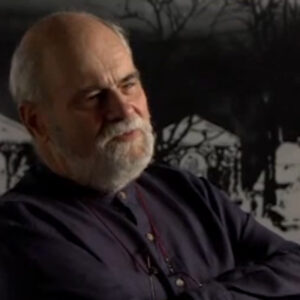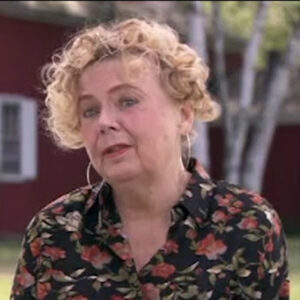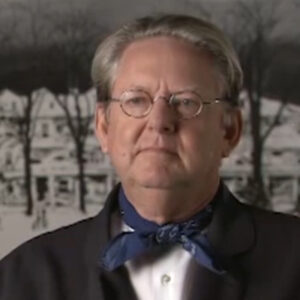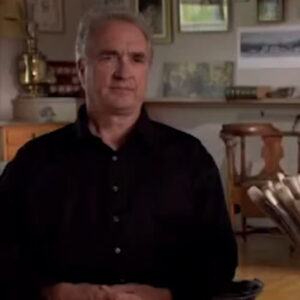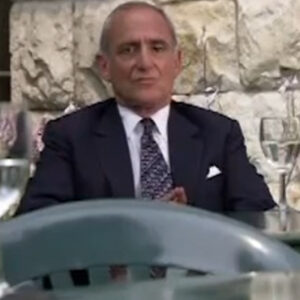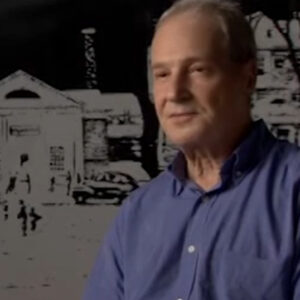Speaker OK, tell me about your first memories of Rockwell.
Speaker Well, when I grew up moving around the United States and so the Saturday Evening Post and all of these sort of national media were kind of the normative documents in my life. And so I can remember looking at those covers and, you know, as a kid, you take whatever permissions you can find. And so I think that the thing that I always remembered about them is I’ve set of buses that the kids are always OK in. Rockwell and Rockwell always issues permissions and and, you know, indignities and improprieties are always forgiven. And the police are okay. And everybody is you know, and I can remember thinking about that. And I think that the thing that is hardest to for people to remember is that this wasn’t the norm. And 40s and 50s America, I mean, 40s and 50s, America was hostile and distrustful place. So any sort of emblem of tolerance or forgiveness was was something that to which one was drawn. I was thinking the other day I was looking at some Hogarth’s. And, you know, Hogarth is so tough ins and so mean, so hard. But at the same time, he was tough and mean and hard in the midst of a rampantly sentimental culture. And Rockwell was sort of sentimental in the midst of a pretty hard and distrustful and pessimistic post-war culture. And I think that’s what what people loved about them.
Speaker That is hard for us to remember. I mean, like when you were writing about how parents thought of their children in the 50s compared to how Rockwell was painting them, if you can articulate.
Speaker Know this, the age that invented juvenile delinquency, you know, and rebel without a cause and all of that. They I mean, you know, these.
Speaker It was a generation of little creatures that these people had no idea. You know, a generation who grew up in relative comfort.
Speaker And the people who had grown up in the Depression and lived through the war simply had no idea how to deal with that. With that kind of. Generation with those kind of kids, and not only that, they were sort of, I’m sure, subliminally jealous and distrustful about that. You know, I mean, I you know, by the time I was five years old, I must have been in, you know, reminded a million times that I didn’t fly 50 missions over Italy.
Speaker Or like, you know, or I didn’t have dried apricots for Christmas dinner during the Depression, you know? And so you were you grew up sort of vastly aware of your inadequacy and your privilege. And so Rockwell’s pictures really tended to sort of. You know, in Rockwell’s pictures, that was the culture was about being creative kids. And so they’re very attractive.
Speaker You know, give me some examples in Rockwell.
Speaker Well, that great picture, the runaway with the little kid who has run away with his little Bendl and he’s and he’s been collected by the policeman. The policeman takes him to the soda fountain and and buys him a soda found. So he’s sitting there with the nice policeman and the the little girl with their black eye grinning outside the outside the principal’s office and all of those things in which indiscretions were basically forgiven.
Speaker And all of these all of these situations, you know. You know, kids really identify with that, with getting away with it.
Speaker I had to you know, as I say, I always imagined those kids who were my age. I mean, you know, the kids in the in the pictures were my age when I saw them. And so today, I imagine them growing up the way I grew up, you know, which means that the kid with the Bendele in the runaway 10 years later is out on the highway hitchhiking to San Francisco. And the girl with the black eye is somewhere burning her bra. Words that this sort of atmosphere permission really did inform the culture. I think.
Speaker It was because that’s all Rockwell does, is he offers permissions and not just permission to disobey, but permissions to sentiment, you know. You know, in Rockwell, it’s OK. Like, you know, and think he’d take things like that. And. And I think that was the real gift of the book comes out of it. It comes out of a.
Speaker An attitude about popular art that doesn’t exist anymore. Today, we do nothing but niche marketing and identity politics. Popular art in the 50s and early 60s was really addressed to everybody. You know, it was addressed to the whole culture. It wasn’t just addressed to that niche market of 22 to 24 year olds who live in walled communities outside San Marino. You know, I mean, it was so in the process of of of of trying to please everybody. They just instinctively forgive everybody. And so that so just the conditions of trying to please everybody becomes as much of a discipline as trying to please no one, you know. And so it makes the pictures very complex, actually. And in it and it really means that Rockwell is always trying to deal with some sort of specific historical situation. Kunzmann you know, when you look at Rockwells, I mean, the thing that I’ve always found so interesting about them is that when he’s doing ideas, he’s really awful. I think, in other words, when he’s doing like freedom from want, you know what he’s doing sort of concepts when he’s doing really historical moments even, you know, that is the scenes are always even though they’re domestic scenes or historical moments, they’re at a particular moment. This is happening in the world. People are going off to war. Junior is going off to college. They’re always specifically kind of historical occasions. And. And as a consequence, it even if you couldn’t identify with a specific sort of relationship, you could always identify with that moment. And. And I think that’s why, you know, as I call Rockwell, a Democratic history painting, he’s talking about how history happens right down here on the street. In other words, there’s there never just pictures like traditional European genre pictures, which are just people playing cards or are people playing guitars and wasting their time there. Everybody’s always engaged in something to do with the daily life of the republic.
Speaker You know, mom and dad are arguing about politics or mom and the kids are going off to church while dad sits home and reads The New York Times and smoked cigarettes in a fake meat chair. And, you know. And so it was always this aspect, I think that that makes Rockwell. I don’t know how people who didn’t grow up doing during that period feel, but I feel like they probably have to sense that this was the way it was at that exact second. And and that, I think is is, you know, that’s a real gift. And it’s not something, you know, that.
Speaker American visual art does very much American doesn’t have real tradition of popular visual culture. The popular culture is musical in America for the most part. And so, Rockwell, you know, as I say, he was the first. Artist, visual artist who tried to please everybody. And.
Speaker Excuse me, however strange that might sound. That’s real discipline and I always compare him to Richard Rodgers or Johnny Mercer or Jerome Kern or people who are doing musical art at that time and trying to trying it to a certain level to speak to the whole culture.
Speaker And.
Speaker And there there are certain aspects of it. What you give away. Say, if you if you compare it makes Rockwell’s painting, in my view, look very French and very English compared to, say, French genre painting during the Napoleonic Air Quality. Most specifically. And pre Rafiah like painting because it is a. It’s all about little bitty things happening every day. Unlike Dutch painting, Duchon repainting. It’s not sexy. You know, Ducharme painting is sexy. It’s about physical desires and people drinking and eating and and hitting on each other and everything. So it’s very sort of visceral.
Speaker Rockwell’s vision is much more petty, bourgeois, nice people doing nice things. But what was it that made Rockwell uniquely American?
Speaker Well, I think what makes Rockwell neat is uniquely American to me as a painter. Is the is just the absolute commitment to.
Speaker The idea of growing up in a democracy or just idea of growing up, which is kind of what Rockwells pieces are all about. I mean, you see the people in Rockwells. Paintings. You know who they were yesterday and you have an idea of the kind of life that they’re on their way to tomorrow. In other words, if you say compare Rockwell to an Edward Hopper or to a.
Speaker A wife. Which is to compare him to a very good painter in a very bad painter.
Speaker Even Hopper’s figures are trapped in their moment. Hopper figure is isolated in time and isolated in that moment in the thirties or in the 40s. You don’t get a sense of this sort of ongoing life. And of course, in why I think just out there on the farm, looking anxious and pretentious and all alone and other do these sort of isolated sensibilities and informed with Puritan angst.
Speaker But Rockwells people are always living there, like on their way to living there, wearing the kind of clothes you wear in a certain situation and you wear something different the other day. Or they’re trying on clothes that don’t fit, are there? They’re wearing clothes that, you know, that is the sense of them just living in time is is something that Rockwell gets probably better than anybody. And and it is it is the sort of thing I think it is an attitude that you see in movies today and you see in sort of good situation comedy where there’s a lot of attention to detail.
Speaker But you it’s not an aspect of them, of American painting, and it’s not really an aspect of American photography. I guess you could kind of say that Robert Frank is kind of more Rockwell, but that would be a disservice to both, probably.
Speaker But you’re saying that Rockwell was really painting American society or something, saying something about our society, was talking about Americans in history.
Speaker I think if you if you go through Rockwell and look at this, there’s that there’s always a little kind of. They’re always sort of off the moment, you know, that that really nice picture of the the sailor and his girlfriend underneath went the window at the university club. You know what? The guys. That’s like one moment in American history. You know, that’s like 1945 or 1944, right. Then forever. And even though the university club is they’re still there. The rest of it’s not. And I and I think that’s one reason that people think of Ross Rockwell as being nostalgic because he really does capture that instant. But I don’t think he’s really so much into the past as he’s as I say, he paints the present as if it were the past. In other words, he’s trying to catch it all right now because tomorrow it’s going to be a different world. And and I think that gives the pictures the kind of kind of, you know, that golden low. But I don’t think that was his real intention. I mean, I actually have all of the things I respect about Rockwell as his deep commitment to making good pictures. I mean, they’re really good pictures and they’re very artfully composed and they’re very thought out within the tradition of social painting that begins in the 17th century in Europe and in France and in England and in Holland.
Speaker And it is and he is the last painter in that tradition. But that doesn’t mean he’s bad. Tupelo was the last painter in the Mannerist tradition.
Speaker And he’s still pretty good, but didn’t want to make that comparison.
Speaker Looking at Rockwell, it’s kind of like you can look at a great Tupelo and you can see that Tupelo was like plugged into an energy source that has been plastered over. You know, I mean, you don’t feel that way or think or and in Rockwells the same way you look at those great Rockwells 50s thing and he’s plugged into an energy source that is just not available to us anymore. I mean, today we do demographics and identity groups and all of all of this rhetoric of separating people out. And, you know, Rockwell was foolish enough to think that he could include everybody. And and at a certain level, he did. You know, now he issued permissions that people took advantage of in ways.
Speaker That smy, Perry Mason pause. You know how he does that? He said, Well, Paul beat beat. I think he issues permissions, which I’m sure I’m sure of the consequences of the permissions that Rockwell. Issues are not exactly what he would have liked, but I don’t actually think he would have he would have minded them. What do you mean? Like like. Well, he forgives he forgives kids for messing around with I think with the implicit presumption that they’re going to still mess around when they’re grown up. You know, I always I always imagined it’s like he’s proposed. Your question. Can you have Hugh Hefner’s playboy without Norman Rockwell? Because the whole ethic of Playboy was girl next door. Eros, you know. Girl next door in the little Rockwell. Dine it without any top on. Right.
Speaker But in a sense, it is that sort of benign, kind of anxious environment of the American home with naked girls in it. You know, that is. Could you have that if you didn’t have that ideology of sort of girl next door, sweetness and goodness? Because that’s really what makes Hugh Hefner, Hugh Hefner so tend to go. You know, is the idea that nice girls like sex and the nice girls and Hugh Hefner all all come out of Norman Rockwell backgrounds? You know, especially early on.
Speaker So let’s take no swimming.
Speaker Right. Well, sure. I mean, you know, this what is in the first no swimming is 19, 19, I think, or something like that. And the second one is something like 1956. And, you know, the first one is the kids running past the no swimming sign. And they’ve been no swimming and they’ve been and they’re out there and they’re dog and they’re running. And then he he comes back in the 1950s, repaints the same picture with the same guys. In other words, they’re like 40 years old and there’s still no swimming. You know, they’re still breaking that rule. And I think that’s. But I think so that this is the rule. And Rockwell, people are not going to behave. And people are really going to be different.
Speaker And there’s there’s really only one virtue in Rockwell, and that’s tolerance, like, hey, we’re all different. Get used to it. You know, that’s that’s the whole moral of everything that you see in Rockwell. There’s that famous painting that is always used by sort of people who advocate the Rockwell as a kind of conservative icon. It’s called saying, Grace, I’m there’s a picture of a grandmother and the little boy, and they’re in this bus station and their kids are saying, Grace. And all these people in the bus stations are looking on. And the general presumption, of course, that this is Rockwell advocating family values and obedience to authority and traditional religion and public prayer.
Speaker In fact, what the painting is about is about the fact that all the people around them are tolerating this. In other words, that’s the real subject, is the audience. And what Rockwell is telling us is that, OK. Let him go ahead and do that, you know? I mean, in this nice that these people can pray in public and all of these guys with their cigars and their newspapers will not bother them or make fun of and will look benignly on it.
Speaker This sort of manifestation of cultural difference to use the rhetoric. And I mean, that’s the real subject. And that’s the subject in nearly all Rockwells. It’s always the people that are beholding the over and over the transgressive or the strange behavior and who approve, you know, and so there’s it’s always the idea of people approving of other people. That painting that I like so much called after the prom with two kids after the prom in the soda fountain. And the veteran is sitting there and the soda jerk is there and they’re all paying attention to these kids and in their dorky clothes and the little gardenia corsage and all of this. And the subject is not really the kids. The subject is the fact that people are being nice to him. I mean, just like the subject in saying Grace is that people are tolerating, you know, tolerating other people. And so, I mean, I think that’s for me. You know, having grown up with with Rockwell, I think that’s the most important part. I could never understand why people got so, you know, would conceive Rockwell as some sort of an ideologue.
Speaker You know, I that was never.
Speaker Part of my experience of them, but I was going to say, I mean, I think most people would say that Rockwell helped create a unifying vision or identity of America, but they would say that it’s it’s not about talents and people were different. I think most people read him as being, you know, painting a sort of a monolithic society.
Speaker Well, I think if you really look at the pictures, that’s not really what’s happening. You know, you’re one of my.
Speaker I mean, I always thought that I’m sorry. I can view them on. Nobody heard my questions.
Speaker I understand. OK, if I if that is I don’t think it’s a very monolithic society at all. It is.
Speaker You know, nearly everybody’s white. Well, that’s true.
Speaker And and I don’t think that working for the Saturday Evening Post, there was much choice in that area. But the picture that always reminds I wish I had the title.
Speaker The picture that most characterizes Rockwell’s view of history is this picture. I think it’s called moving day or something, which a giant moving van is trying to make its way down a little teeny alley. And people are hanging out the windows and stuff. I mean, for Rockwell, it’s just always this kind of tumult of things. Are things changing and people are looking and people are talking and all this stuff is going on. And to me, that’s what Rockwell is about. It’s always so, you know, he’s always dealing with these transitional moments. The, you know, the the the the couple, the farmer’s wife sitting on the pickup truck or the farm. And it’s I guess it’s the farming, the son sitting on the pickup truck and he’s going off to college. And again, you know, and this is a very emblematic picture of that particular moment in America, the moments of sort of urbanization, rise of public college education. I mean, it’s it’s a lovely, emblematic picture, but it’s not an emblematic picture of anything particularly traditional.
Speaker It’s an emblem of change, just like the I was trying to think the picture of the of the guy, the soldier home from from the war who’s sitting there peeling the potatoes with his mom. It’s just a specific moment of historical transition. And I think that, you know, I mean, there are some pretty traditional.
Speaker I mean, Rockwell. The picture shuffled tons barbershop picture.
Speaker Which, you know, is somewhere between a yarn stained musical picture and a Robert Frank photo. In other words, you have all these old guys in back in the barbershop playing music and you’re looking through the the front of the barbershop. Very much. There is a Robert Frank that’s very much the same setup.
Speaker And that’s a fairly traditional thing. But it does have to do with the way the sort of the informal gathering of human beings in a little town to do something that’s that’s consequent. And I don’t. And again, maybe maybe it does portray a monolithic society. But I grew up moving all over this country.
Speaker And and, you know, I don’t remained, you know, until I got into graduate school. I don’t remember anyone who is very upset with Norman Rockwell. You know, I guess when I was a kid, I had some beatnik friends that thought it was real corny, but it’s like nowhere man.
Speaker But you’re saying he did tap into almost every American’s soul, if you will, in some way.
Speaker And I thought, well, I don’t think it’s really ever well. Okay, here’s the thing.
Speaker As I’ve argued somewhere that the minute that Rockwell became involved with Erickson and Coles and all of these sort of psychology types, German psychology types, his view of things changed a great deal. Rockwell is never about what’s going on inside our heads. It’s always about what’s happening in the world between us. In other words, it is not about Protestant interior life. It is not about one man, one book, one God. It’s always about this society. It’s bad externals. It’s about relating people, relating in terms of external objects. And this is, I think, Daniel Hofstetter. Somebody argues that this is the peculiarity of Americans since we don’t have any cultural identity. I think he proposes, you know, if you’re in an Iowa town in 1920 and there are black people who have come up for the south and there are Norwegians who have come down from the north and there are Chinese who came through with the railroads, and there are appellation people who have come west. And you have this sort of community out in the middle of the out of the middle of plains. What do they talk about? They talk about their forward. They talk about their singer sewing machine. They relate in terms of these external objects. And we still do that today. You know, if I’m if I’m sitting somewhere playing cards in Vegas or something, I can talk to anybody there. We can talk about TV. We can talk about the Lakers. We can talk. In other words, Americans relate to one another in terms of the sort of external cultural icons. American culture is is a is a extremely externalised culture. And this is very hard for people who have been raised in the sort of Freudian Protestant tradition of internal life to understand, you know, who who value that in interiority and the idea of, you know, personal identity. And all of these Americans in general world that I grew up in is not that kind of world, Germany, that kind of world. In other words, it is a it is a country that in which in turn, one’s internal cultural identity, one’s tribal traditions, one’s relationship to the soil is very important. And in the America I grew up in, it’s really been like that at all.
Speaker So Main Street Stockbridge is kind of an external symbol of our community name. And what might that meaning an icon.
Speaker And it’s kind of a boring painting.
Speaker I don’t think it’s very good. Well, yeah, just clarify what you’re talking about. You know, when Rockwell started to meet Erikson Coles, what era are we talking about? How did he change?
Speaker Well, in my view, he is he sort of bought into a kind of 60s rhetoric.
Speaker And a witch sort of.
Speaker Permeated the culture at this time. The efforts because of I think basically because of Jack Kennedy, his political campaign. These efforts to get us to conceive the nation as a unified culture. You know, and I’ve always felt that, you know, Calvin Coolidge was right. I mean, America’s a big business. It’s not a unified culture. It’s got thousands of different cultures in it. But when you have the president saying as not what your country can do for you, ask what you can do for your country. That’s it. That is in American history, a very peculiar idea. You know, it is a long way from life, liberty and the pursuit of happiness. And it involves a kind of New England puritanical cultural ridker and a whole sets of sort of more geishas and an idea of public culture that is not really much present and in the history of American culture. And it also means that once you have done that, then you start thinking of the culture, not in terms of lots of individual people, but in terms of sort of cultural icons and just sort of celebrity rhetoric where people stand for things, you know.
Speaker So what happened to Rockwell on this early 60s?
Speaker What happened to him? Well, it started you went into psychoanalysis.
Speaker He started thinking and sort of archetypal European ways. He began selecting rather than finding, you know, specific Americans who were typical. He began to selecting a typical Americans who were served somehow symbolic of things. So he’s you know, he’s not painting kids. No swimming. He’s painting Jack Kennedy. He’s banning astronauts. He’s painting Peace Corps workers. He’s dealing with at a level of generalization that he has never dealt with before. And he’s also dealing with ideas. He’s not dealing with narratives. In other words, there’s not a there is not a bit of narrative. And most of those like pictures, they’re. The same transition took place in. Victorian culture between about 1850 in 1880, when you go from this sort of social complexity of the early Charles Dickens to the kind of formal, virtuous representations that you see in a Lord Layton tableau in which all of a sudden things stand for things rather than nerit things. And I think that American culture went under, underwent this kind of change.
Speaker And and in a sense, it has to do with the great moments of of urbanization and the history of the West. But I mean, this may be used will create these moments of incredible social fluidity. You talk about London in the 1950s, in America in the 1950s, where up and down and high and low all kind of blend into each other. And you can look at British culture in the late 19th century, American culture in the late 20th century as an effort to reinforce social hierarchies. You know, this is what High Victorianism is about, is getting the uppers upper and the lower is lower. And I think that this is what happened during the Reagan years would just begin to re-establish sort of the class divisions in the art world. It was really easy to understand the art world of the 60s. You would go all the way from millionaires to dope dealers to derelicts to artists. And a party would be this enormous mixture.
Speaker By 1880, that was simply no longer the case. 1980 90 excuse me, but not by 1980. This was simply no longer the case. All of the bottom was gone. No more street trash at the opening. And in a sense, the top was going to be no more millionaires at the opening, just nice, respectable artists and collectors and art professionals. And so but it’s that kind of reimposition of social order in the wake of these urbanizing moments. I think that happens.
Speaker You such a sort of tough phrase for Rockwell, you said, but he went from painting the ordinary man to becoming a paparazzo.
Speaker Right. Well, I mean, what does it mean? You know, when this guy who has devoted his whole life to painting ordinary Americans into thinking about himself as an ordinary American begins to thank him.
Speaker Think of himself as some sort of, you know, acolyte in a renaissance court who’s who’s going to go in and paint Jack Kennedy. He’s going to go in and paint Alan Shepard, who’s going to really show us the really great people. This is a whole different idea of what symbolizes the society itself. If you talk about, say, French culture and British culture in the 18th and early 20th century, the culture is presumed to be embodied in its civil service. You know, in those people who represent the culture, who went to the nice schools, who run the museum, who teach in the thing, American is always assumed that America was represented by its regular people. You know, that that that the icon of America was just an ordinary, disheveled American person. And all of a sudden, it’s Adlai Stevenson. That’s James Schepper.
Speaker It’s like it’s no longer paintings of the West. It’s paintings of a movie about the West. And, you know, it is like he just simply stepped back and rather than creating sort of representations of everyday life, began painting representations of representations of ideals. So and that’s a very kind of you know, that’s an abstract kind of activity. Was he just a popper up so late in his career? Pretty much. Pretty much what? Nobody. I mean, a light line is created, pretty much a proper art. So and also, he you know, he the 60s kind of invented this idea of America’s great therapeutic power elite. That whole sort of Kennedyesque rhetoric of all us nice, strong people who have rich trust funds are devoting our lives to helping us poor slobs do well. And Rockwell kind of joined that club and having that joined that club. He abandoned the club of, oh, I’m just Norman Rockwell going around collecting old uniforms and painting pictures of ordinary Americans. All of a sudden, he’s flying around the world looking at Peace Corps projects in India, hanging out in Hollywood, you know, with with stars. He just moved into this new celebrity culture. And I’ve seen this happen to you know, you can see it happened to Rockwell in the history of American music. I’ve seen it happen to songwriters, you know, great country songwriters who started off writing about the people. And the next day they turn around and they’re writing about themselves on an airplane. In other words, that just you can lose. You can join the club of celebrity and lose contact with where the world is.
Speaker I think one of the reasons was that Rockwell himself was always apparently struggling with, you know, the desire to be more than just an illustrator or paint the big painting to deal with big issues. I mean, what was going on?
Speaker Well, exactly.
Speaker And again, artist routinely mistake their gifts is, as I say, you know, Rockwell fought that by abandoning narrative and illustrating these big issues. He was somehow establishing himself as a major painter.
Speaker He was already a major painter. Are the paintings of the late 40s and 50s are real, true icons in the history of American culture. But by trying to be.
Speaker This is so he’d disassociated. I mean, he mistook the idea of great art and high art. They’re not the same thing. He wanted to paint high art, which means that it’s abstract and that it’s about ideas. This is the traditional American fallacy, is to presume that that great art is somehow more conceptual than ever other art. And so, in a sense, in his own primitive way, Rockwell’s late of his all conceptual you know, it’s an illustration of the golden rule. You know, it’s got text on it just like conceptual art has and.
Speaker But Rockwells daily practice was great. I mean, and Mark Twain made the same mistake. I don’t know if you’ve ever read Joan of Arc, but Mark Twain thought that Huckleberry Finn and Tom Sawyer were just these things. He typed up or wrote out and did this Joan of Arc, which is a promise you one of the most boring novels in the history of the world, that this was his major gift to Western civilization. It was a terribly boring picture. But Joan of Arc, Alan Shepard, you know, I mean. And so that that that instinct, it’s a leftover of sort of high Victorian culture, the dissociates seriousness with quality.
Speaker And and it was the Victorians who decided that tragedy was more important than comedy and and peer to New England, of course.
Speaker Agreed. How should we think of Rockwell all over the body of his fargus just an illustrator, something.
Speaker A great narrative painter. And and as a maker of exquisite pictures, I mean, he’s just a master of arrangement. I mean, the pictures are very handsomely made. Look at Iraq. Well, picture and try to try to think of a way to change it. And you will see that they’re not changeable. They’re absolutely locked in there and they’re absolutely memorable in their arrangement. In other words, these gifts were, as a painter, essentially formal because he was painting to be reproduced. And so the sort of tactile fractal, chromatic aspects of his work, even though he’s very competent, are not important because we don’t ever see that. We just see that. We just see the four color illustration. So arrangement is everything, just like arrangement in the lyric by Larry Hart. You know, the content of in a mountain greenery where God paints the scenery, you know, is not really that important. It’s all in the arrangement. And that’s what makes it last.
Speaker And I can’t find many pictures of that sort that compete in such a sense of just sort of formal accomplishment being that way. Take me through, say, after the prom briefly. I’ve read about that. I know. Well, if you look at after the prom.
Speaker It is arranged in two overlapping rectangles with whole systems of rhyming 45 degree angles.
Speaker If you if you look at the picture, you have these two young people sitting on counter stools. So these stools function like pedestals. They’re lightly poised up there in their white coat, in her white dress. And this kind of dark world in which there is a heavy guy sitting here, heavy soda jerk leaning on everything. And these kids are raising up so lightly and perfectly arranged. If you look at that, the the the gestures here, you will see that the rectangles are very carefully the angles are very carefully rhymed.
Speaker So that in on the left hand side of the picture, you’ll see the angle that the that the fed her on. The guy that’s sitting on the stools leg makes is exactly rhymed and rotated in an angle so that it picks up the angle of the soda jerks arm as he sits on the on the thing and the swings the picture this way. And so Rockwells also has moved the center of the picture in that exact direction. He’s moved it to the right and up off the center of the picture. And so that there’s there is a kind of rhyming composition. There are the kids, the sightlines and everything are all perfectly arranged. So they’re harmonic with the angled of everybody’s arms. But the main the main effect of the pictures to emphasize the lightness of the kids and the heaviness of the of the adults there. Now, as I point out, this is the opposite of a European painting in which you would have two adult lovers laying in a bower and then there would all be these light flying children around. So Rockwell inverses is we have these children on the pedestal and their sort of whiteness and brightness surrounded by this kind of brown, everyday, weighty world. And if you look at the picture, the weight of everything is emphasized, except there’s the girl’s sweater is hanging over the arm of the young man. There are keys hanging off the out of the back pocket of the veteran, the veteran sitting heavily and leaning the soda jerk, his leaning. These kids are just floating there.
Speaker So we’re talking about after the prom.
Speaker Right. And I was saying it was talking about how so much of Rockwell’s content of Rockwell’s pictures is not in the action, but in the response. And if you look at after the prom, you have the soda jerk leaning over to smell the girl’s corsage. And she is e smelling this sort of white thing. The fragrance is sort of symbolic of their young love. And everybody is looking on our relationship to the figure of the kids. This white. Cluster of paint here in the middle is the same as the soda jerks relationship to the freight, to the to the gardenia. So we’re kind of inhaling the fragrance of this scene here in a larger level as he inhales the fragrance of the corsage. And so this is the cue that tells us what we’re supposed to be. Doing and the people and the people looking on the soda jerk and the guy are showing us how to respond. So kind of you could say that Rockwell is teaching us to be nice. You know, in other words, he’s showing us a situation in which democracy works or in which in which relationships across generations are successful and benign. And I think that’s what the veteran there, the guy in the Air Force cap and the bomber jacket is sitting there because we were talking earlier about all the hostility toward kids in the 50s because they didn’t fight in the war. And to have that veteran there looking at these kids after the prom is really to tell us that this scene of the kids after the prom is what this guy was fighting for. In other words, they who are you saying, OK, this is what I was fighting for, this key moment here. And I think that that, you know, again and again and Rockwell, he’s showing us how to be nice. And that’s not the worst thing in the world. You know, a mark, in my view. And I was you know, when you talk about Rockwell’s obsession with kids. It’s really about the idea. A kind of historical idea about democracy, which is that democracy is always about the promise of its youth. You know, because the kids in Rockwells, as I say, grow up and. And so the idea is we want them to grow up feeling free. And and so I don’t see anything but tolerance and liberty in the pictures. I don’t see any sort of patriarchal oppression. I don’t see any sort of ritualized subjugation to established authority. I usually see, like, really weird stuff and and tremendous efforts for us to understand the sort of social circumstances of other people.
Speaker There’s a wonderful picture that since I live. I grew up on the road. I spend a lot of time on the road. There’s a wonderful painting of a traveling salesman sort of ensconced in his hotel room in the middle of nowhere. You know, that really captures that. There is another picture of which I like a great deal, and I don’t remember the title of it, of the traveling salesman who has stopped his car by the bridge and has taken off his clothes and has gone down to swim in the swimming hole. A perfect little moment, but it is you know, it’s again, it’s easy enough to talk about the kid and all of us. But in Rockwell, it’s not really so much about the kid and all of us. Is it about us respecting the kid in all of us? In other words, about us understanding that nobody ever grows up and saying that that’s essentially all OK. John Adams, to the contrary.
Speaker You were talking before about Rockwell painting change or talking about change? My thing is the TV, the new TV set painting to which I was at one TV and I’m like, oh, yes, moment of right. You talk about that? Well, no, because I don’t have it in my head. We all sort of marking this moment of, you know, an old house with they were installing.
Speaker Right. Rather installing them. They’re all up there adjusting it. But this is always what’s going on in Rockwell, just like that. You know, the kind of corny pictures of the the black kids moving into the white neighborhood where it’s like the black family and the black kids with the white paint and the white kids black bad. It’s a dog or a cat or something like that. But this is this is what Rock was about, is about how things how things are changing.
Speaker But it’s also, of course, like all popular art spat it, you know, Plew assurances about how they don’t change, you know, how. OK. This is different, but it’s not that different. I was. That is the. But it does a lot of the things that are just. A lot of what Rockwell does is about sort of collapsing hierarchy and a lot of it’s, of course, about humanizing authority. It’s about making the doctor nice, about making the policeman nice is as as I say that, you know, if this kid in the in the run away, rather than going to San Francisco, ended up in Chicago during the Democratic convention, he discovered another kind of policeman altogether.
Speaker So there is that. I mean, I’m not saying he’s a genius or anything, but I think what he does, he does very well. He captures narrow.
Speaker He does two d one instant narratives, which means that the moments that he captures have above implied before and have an implied after. That’s very amazing. And. One of the power of this image is the basis of 98 percent of the movies we see from Hollywood. They all began in Norman Rockwell. In other words, look at the first opening sequences in our. Independence Day.
Speaker You know where Will Smith is out in the neighborhood with his wife, with his kid on the street, picking up the paper, doing all this Norman Rockwell stuff. And then the spaceship appears over here.
Speaker The whole first of E.T. is like this enormous cornucopia of Rockwell devices of domestic, the domestic sublime.
Speaker And over and over. That’s what that’s what most contemporary movies do. They set up this domestic supply, this perfect little thing. The kids are have those. What’s his name?
Speaker The actor that’s in. The famous famous actor that was in Indiana Jones. What’s his name?
Speaker Harrison Ford at the Harrison Ford spy movies. You know, where he’s the spy that works for the government from the Tom Clancy books. All of those, you know, have Harrison Ford going out and saving democracy. But they all starred in the scene with the breakfast table. The little girl having the Rice Krispies telling mom who had to go to the grocery store, and then he goes off and fights the war also. And all of these movies, all Steve Martin movies are basically Norman Rockwell setups, you know, and they set up this basic and then either the bureaucrats or the mob or asteroids or aliens come in and ruin this. And then we somehow reestablish some possibility of the restoration of this Rockwell and universe. This is sort of the narrative.
Speaker You know, Norman Rockwell’s universe is threatened. Norman Rockwell’s universe is reestablished. I mean, that’s the narrative of three quarters of the of the popular narratives that we have. It’s absolutely persuasive. And the iconography, you know, the grandmother, the kid that, you know, the spunky little girl, the little bratty boy. I mean, this is all Rockwells. I kind of the breakfast nook. Nobody has breakfast Nook’s any way except in Rockwell and in Hollywood movies, you know, and advertising and in advertising.
Speaker Yes, exactly. And as I was thinking the other day, the difference between people on TV and the people who watch TV is that people on TV don’t watch TV, you know.
Speaker But but but this idea of this domestic sublime is Rockwell’s idea.
Speaker I mean, the visual iconography of it is Rockwell’s idea. You see, there’s a show. There’s a movie. Called a Christmas story. They show it about the nine year old kid who’s trying to get a daisy read, write or be begun. That is the whole movie is just like a collection of Rockwell clichés. You know, it is it is the assembly of detail and the kids and everything is all kind of based on on this particular world.
Speaker And it is a cliche, but things are cliches, you know, because there’s there’s elements of truth in them and know you can say, oh, yeah, well, everybody’s nice. And Norman Rockwell. And it’s all peachy keen. But in truth, if you really ask, you know, what do you want for democracy? You say you want to be able to. Live an ordinary day without pain and without shame. In other words, you want to live in pain, but you do want to be ashamed because everybody else is living in, you know, misery. And. And this is a kind of social call. We’ve kind of forget. We always think we have to make the world safe for democracy or go to the moon. But the ultimate function, that sort of idea of the pursuit of happiness is this sort of tiny little. You know, this sort of tiny, little quotidian everyday life. I mean, that’s what’s really being proposed in sort of the IDF kind of Jeffersonian democracy to me. And it’s not a and that’s not enough, of course, for pure to New England. And it’s not, you know, because it’s too much fun and it’s not really enough for hedonistic California because we’re not really dealing with the intensity of erotic, you know, excitement. I mean, you met a bit, but Rockwell’s words about effort. No pain, no shame. Is is a perfectly valid goal for the way you run a society.
Speaker It seems to me at least to say, you know, it’s a kind of ground level assumption and it won’t work and it can’t work. I think that what Rockwell understood, unless there is a level of. Sort of. Forgiveness and tolerance. You know, the nice thing about the the picture of the sailor and his girl outside the university club, of course, is that these guys are not looking hostilely down at the scene.
Speaker They’re looking enviously down at the sea, you know, from their bankers, bankers perch up there.
Speaker And that’s not what art is all about. But it’s part of what art is about.
Speaker You know, part of it is about, you know, proposing these sort of situations in which things kind of work. There’s nothing wrong with that. Rockwell did it very well. And if it was easy, everybody would be doing it.
Speaker Well, what about rock on an art world? How?
Speaker Well, most painters I know that know anything about making a painting really respect Rockwell because he really knows how to make a painting. He knows how to do the robot out of the rectangle. He knows how to shift the balance of a picture and do the color arrangements and all the sort of mechanics of making an image in paint in a rectangle.
Speaker De Kooning was a great admirer of his paint handling. He said he didn’t mess up. He didn’t he’d never call attention to itself. Warhol put Warhol loved about Rockwell. You know, from my experience, there was he loved the ordinary domestic confrontations in Rockwell.
Speaker And if you look at all the early not so much the paintings, but the films, what you will see, what Andy liked to do was to set up a camera just like that, put two people on a couch face to face, which is the image that you see, which is the classic Rockwell image to people in profile looking at each other and let them talk and just see what happens and all these. So this is basically Warhol extending this idea of this Norman Rockwell face to face situation off into the realms of underground film. So if the fact that an Andy that there’s a neurotic speed freak and a transvestite talking to each other, that’s really just Warhol taking this sort of social idiom and extending it, you know, and. And so Andy really like Warhol and Andy, liked anything that was popular. I think that’s reasonable.
Speaker But he did it for the for the reason that things that works of art are their fame. In other words, what the artist meant.
Speaker What the curators think it means, what the critics and what it means is what the people who love it think. And this is an end.
Speaker So about Andy’s criteria, Rockwell’s great owners.
Speaker Well, other analogies between Warhol and Rock on the sense that they both took objects of daily life well and turned them into icons. Mean with almost sort of a religious well with Andy.
Speaker Andy is always making icons in a Catholic sense. In other words, he’s turning a photograph of Marilyn into an incarnate icon of Marilyn. That is an object is a flat thing. I think that only in a conceptual sense does Rockwell do this. Rockwell is a promise to a picture maker, you know, and but he does understand what Andy calls what I was talking about before is one called the democracy of objects. When I was talking about the people in Iowa who talk about the Ford, that was one thing Andy talked about all the time, which is the best thing about America is that the president drinks Cokes and I can drink Coke because if you want a Coke, there’s nothing better than a Coke. He doesn’t. So it’s that these objects really form the kind of social glue through which we all relate as external social beings. And and what what binds Rockwell and Andy is the idea that we are who we are in the social world.
Speaker We’re not who we are when we’re alone. It’s, you know, thinking about our problems and standing somewhere thinking, well, I may look like a frog, but I’m really a prince inside in Warhol and in Rockwell, everybody lives on the outside. It’s just extremely exterior ised idea of society. And it’s not about culture, culture, something way up here. Society is what happens every day. You know, everyday people interacting. And that beguiled Andy. And nearly all of his films are just about putting people in front of the camera and taking pictures and you know, of what happens every day.
Speaker There is you know, Andy does standard Norman Rockwell setups. He’ll set Henry Kassala in a chair and film him getting a haircut. He has a standard Rockwell material. He will do this kind of thing over and over again because this is an external world and it’s the idea that the value of everything, you know, that we invest in things comes from outside.
Speaker You know, it’s it’s not. You know, the example I was using is Jasper Johns flag paintings, which do the sort of the same thing. What makes a flag important is not that Jasper Johns or Betsy Ross made it. It’s the fact that we salute it.
Speaker In other words, the flag’s power comes from outside and all and the soup cans comes from outside. And all the value in the objects in Rockwell’s picture are invested in them by the people that use them.
Speaker And and so it’s like. You have to understand his Rockwell thinking totally in terms of externals.
Speaker You know, cause as Oscar Wilde says, a gentleman always judges by appearances. It’s always about the outside. And then to find Rockwell involved with with Erikson and Kohl’s and and identity crisis and self-loathing and internalized Freudian difficulties in your childhood. And and and all of these sort of the Freudian family romance muchin.
Speaker I is so far from what Rockwell was about, you know, was about a world that resolves itself, outsiders, about how we behave, very, very 18th century view.
Speaker Of human behavior.
Speaker In other words, in a sense. Rockwell’s ideas about society pre-date romantic revolution in which it was presumed that we are naturally good inside, that society makes us bad. Over and over. And Rockwell, he’s telling us that the social self is the best self. If the society is forgiving. And so that’s really different from this sort of angst ridden, internalized romantic tradition that, you know, that is the dominant tradition in American art. Of course, with the possible exception of Scott Fitzgerald.
Speaker What about today? What’s going on in art today? And it doesn’t drive in any sense for Ron Paul. How should we think of Rockwell in relation to.
Speaker Well, Rockwell is the father of pop, just in the sense that all of those artists were his children. I mean, they’re they’re all artists who grew up looking at Norman Rockwell and valuing the quotidian artists.
Speaker That’s not an issue. I want to talk about this in a terrible mess. No, but in truth, I mean, just to speak, in fact.
Speaker We have throughout the 70s and 80s, the art world became heavily academic, assessed and institutionalized so that art flowed through museums and universities and degrees and comes tilers in this world. And at this moment, I can’t predict the future, but it’s all falling apart. And so you have a resurgence of of artists participating in what I would call lumping commerce. You know, you make a painting yourself, Giberson wienies, get some galleries, you make another painting.
Speaker But I mean, I’m thinking of artists. Painters like Alex Katz and Michail also deal daily American Life. All around us are photographers. I mean, how does their work relate if it relates at all to Rockwell or is it a different kettle of fish altogether?
Speaker Well, if you look at Ricci’s word paintings, Rouget is really interested in the in the verbal aural poetry of everyday life in the sense same sense that that Rockwell is interested in the visual poetry of everyday life and is all the time snatching little phrases out of the air that are at once everyday language and very formally eloquent.
Speaker My favorite being girls with narcissistic personality disorders, which is sort of thing you hear on Ellie Ellie radio every day, but which is also a very handsome sort of euphonic expression because of all the internalized our sounds and it which is, you know, girls with narcissistic personality disorders. So it is these kind of little orderly are one of and has a Paines as I live over in Valley View of which is a very beautiful little phrase. So, so but this is this idea of finding the sort of the the logic of sense in everyday life, sort of physical logic of things and the way they go together or don’t go together. I think this is an important part of American culture and it’s something that is the gift of of Rockwell.
Speaker It’s also the gift of a of what we call a commodity culture, which tends to give us.
Speaker Democracy of objects, which we all share so that people in California and people in New York can talking about the same thing.
Speaker But as somebody said, I mean, art today has cynicism and irony and none of which Rockwell. Not out of what.
Speaker No, I’d actually and I think that irony is a peculiar European import.
Speaker Americans don’t do irony very well. Ironies to say one thing and do another. And it means something else. So you say something that means the opposite of what it means. American art, at its best, does cool, which is to say what you mean in such a casual way that you’re not insisting on it. And this was the great gift, the pop artist, which was simply Andys soup can. It’s not really ironic. People wished it were. It’s just cool. It’s just I like soup.
Speaker So on Sundays, Rockwell, have any kind of artistic legacy today?
Speaker I think he does in popular culture. That’s what’s our number here. Yeah, I, I think and I don’t know if he has it in and I’m sorry nobody heard the questions.
Speaker Oh. Rephrases me.
Speaker OK. I think you can see Rockwell’s artistic legacy in a lot of the art today. If you talk about Alex Katz, his paintings, particularly even though Alex is dealing with a kind of upper middle class, casual artistic society. Alex’s emphasis on the ex Deery authority of his people. If you look at Alex’s paintings, the nicest thing about them is that they don’t have any insights. They are who they are in the world right now, in the world. In other words, we’re not we look at one of the people in Alex’s paintings and we don’t think, oh, he must have suffered.
Speaker We don’t think, what must she be thinking about? We think here are a bunch of people enjoying one another in an externalized social situation. But this emphasized emphasis on the external world and on the realm of the social is really important and moral is very important in Alex’s paintings. And and it is and it will be it is becoming more important with sort of the collapse of what we call the Freudian hegemony. I mean, that is Freud is sort of plummeting out of fashion simply because it doesn’t explain circumstances. And and with the collapse of this idea of this internal Germanic sense of cultural identity, Rockwells world, I think, is becoming more visually accessible to us. You’re doing this right now. You know, I just wrote a catalogue for a show and in.
Speaker And a ladder that’s going to travel all over the world. Everybody’s thinking about Rockwell now. Why? Because it is. And we don’t even we don’t know this in these sort of oh, this would seem the moment to look at Norman Rockwell. It’s just that all of a sudden what Rockwell’s doing looks relevant because Rockwell is about how ordinary people get along in the quotidian world. And we’re beginning to understand that this rhetoric of civility is something we might pay some attention to me. And you understand? I mean, we have an extremely on civil society now. And so that the attraction of what he’s showing us, everything has their moments and everything that goes away comes back. So that’s a pretty good moment to look at.
Speaker Norman Rockwell. It’s not the truth, but no, there is no art is the truth. Hogarth It’s not the truth. The truth is not at issue. It is a proposition about the way the world can go along. And I would challenge I you know, I would challenge anyone to tell me that they have had no moments of everyday life that do not that are not equivalent to the situations with which Rockwell portrait portrays.
Speaker In other words, at some point in all of our lives, which are very long and complex, there are these moments when we’re with other people and it doesn’t hurt. You know, that’s kind of amazing. And so maybe it’s that we value those moments now more since the society is becoming so much less civil. And it is in that social situation that’s that that our that that the sort of our obsessive concern with demographics and difference and an identity dissolve. You know, if I’m talking to some guy at the card table about the Lakers. I’m really unconcerned with the fact that he is the descendants of Albanians who struggled and suffered hedger monarch oppression by the Turks in 1920. You know, this is not an issue. We’re talking about the bleeping Lakers.
Speaker Oh, and I think if you think about the way we get along everyday with people that we know or similarly know what what we we always say. Well, I really liked Kimberly. We have some things in common and that the Ford TV, those are the things we have in common. And and Rockwell is very much about the things we have in common. You know, the clothes we haven’t come in, the objects we have in common. And and I was as and I take a pragmatic view of American history that America is a culture that produces things. And we tend to talk about. Think in terms of the things we have in common. We don’t think about them the same way. The example I always used when I was like in high school and college, the world I lived in was not divided according to race, class, gender. All of these things. It was divided into Rolling Stones people and Beatles people. Now, everybody that, like the Rolling Stones didn’t like the same things about them. But the Rolling Stones were the objective correlative in terms of which one discussed politics, fashion, sex, music, dancing, everything. And this is this the function of popular culture. You know, we talk about things in terms of Norman Rockwell.
Speaker Well, this is no Norman Rockwell. You know, I don’t think we’re in Kansas anymore, Toto. I mean, is so that so that Rockwell is there. He’s an icon. He’s this like that is when you say Norman Rockwell, that proposes an atmosphere, cultural atmosphere, which we can relate to and and discuss. And that means he’s a great artist. Jackson Pollock, great artist.
Speaker Same way you wrote about a single painting that sort of marked. I guess he wrote about sort of the peak of his career marking the ending of, you know, the night guard of the map.
Speaker Oh, right. And he’s actually he sees the night guard in the armory, in the Armory Room at the the museum in Worcester, Massachusetts. And this ordinary guy is sitting there on the pedestal upon which this giant armor clad knight is sitting in the and all the armor standing there and he’s holding the lance. And the guy’s sitting down there having a cup of coffee and reading the newspaper. And to me, that’s that’s sort of the classic. Rockwell is in position, which is seriously and heroic.
Speaker In other words, have some coffee, read the paper. This is what people do. This is all surface in show. It’s all this nightly stuff that where the world really happens is in this a. heroic moment. And this is another way in which Rockwell may be taken to be the precursor of 60s art, which was rigorously anti heroic art in reaction to Pollock and de Kooning and all of this self, consciously Muchow paint his blood expressionism. And he says a soup can. And just like Rockwell says, here’s the knight in armor. Here’s the guy reading the paper, having some coffee, a little bored with all of this. These moments of sort of reaction of a reaction to these anti heroic moments occur over and over in the history of art. If you look in the late 19th century, the reaction to all of the faux heroism of American landscape painting and civil war ideology in Harnett and Peyto, you know, so. OK. Don’t show me any more blood. Don’t show me any more giant landscapes. I don’t want to look at the Yosemite Valley. I’ll paint you this cup with a piece of cake on it. And then this is this is in still half the same thing that rocked the business. Let’s let’s look right here and see what’s right here. That is that is a traditional move in in post heroic moments, 19th century British paintings to the pre raffia lights were willfully anti heroic paintings as opposed to Sir Joshua Reynolds and the people who preceded them.
Speaker I think you said that painting was the last real Rockwell.
Speaker To me, it was the last real Rockwell. After that, he started painting ideas and he started painting platitudes and he started painting celebrities.
Speaker And it all gets very boring. Mostly not because of who he’s painting, but because nothing is happening in the light. Rockwells. There’s no story. There’s no history. There’s no time. It’s just Alan Shepard. You know, it’s just John Kennedy. It’s just the poverty program, you know, and and that’s not a very good subject for art and especially not for Rockwell’s art. When Rockwell’s art is so much about the ways that people deviate from the norm, the way that people worry, not deviate from the norm and insensitive rebelling against it. But just in the sense of being weird and eccentric, you know, as it is that there’s, again, another un-American aspect of Rockwell, which is much more British is Rockwell sort of passion for eccentricity and eccentricity is not, in fact, a deep tradition in American culture.
Speaker It is, of course, in Britain where you find people that collects, you know, have collected snuff boxes since they were four or people that, you know, trainspotters, things like that.
Speaker But Rockwell is was was beguiled by eccentricity and eccentricity, of course, as a way of asserting one’s of a certain difference without status. In other words, say that you’re eccentric means that you’re different, but you’re not better and you’re not worse. And and so eccentricity becomes becomes Rokko of Medea in a very real sense. He. And this is this is really and then when you take Rockwell out of the ordinary world and you’re putting him in this sort of media celebrity heroic world, he just doesn’t have any chops. You know, he doesn’t have anything to do. There’s nothing that he does good. And you just have these boring portraits, you know, and these sort of boring set pieces that, you know, do unto others as you would have others do unto you. And here’s people of all colors and ethnic regalia all around here staring out at us. And, you know, it’s like, Jesus, I’m in a post office, you know? And that’s a long way from the little girl with the black eye sitting outside the principal’s office or the or my favorite little kid with his sick puppy at the veterinarian’s office. All right. That’s art. But it’s very everyday. What else can I do?
Speaker One more question. I could end up on the mat in the white Bronco. Is he going to end up in the metropolitan or some other great museum? I doubt it. You know what?
Speaker Although I would give Rockwell is at least as much longevity as I do those institutions.
Speaker You didn’t have a question about helping him, sir.
Speaker Oh, OK. Whether Rockwell ends up in the mat. I don’t know. He would look very nice in the Wadsworth Athenaeum. He probably should be in the Whitney and probably is actually. That is since the witness history of American art. I don’t think it matters. I mean, we keep things either. We we we find a way to keep the things we love. And when things go out of fashion, we find a way to keep the things we love. And so when de Kooning goes out of fashion, he goes into the museum. Rockwell went out of fashion. He didn’t go into the museum, but he’s still here. I mean, you’re talking about someone who did his last really powerful works in 1954. And and this is the end of the century. That’s nearly half a century since Rockwell, in which he has remained a pervasive cultural presence. And so, you know, so that he becomes an American culture, sort of like, you know, the gorilla in the room. You know, you it’s really hard to ignore him. And there are as many readings of him as there are probably people who look at them. But the point is, people do look him and they do read them. And the value of art comes from the outside. I don’t think it’s important to have him in a museum. I would think he was important for people who want to make pictures, for artists to look at them, to figure out how to make pictures. I think that’s interesting. And, you know, he has this little niche museum up in Stockbridge. He didn’t need to be in a museum. He’s never fallen that far out of fashion. If you look at the great sort of 19th Landseer and Firth in the 19th century genre painters who are not nearly as good. You know, if you were to see those, you have to go up to Manchester and you know, you have to go. You know, it’s like you can’t go to the Tate and see Firth. You maybe can, but I’ve never seen one there. You have to go downstairs at the time to even see pre Rafie Lights. They have them tucked in the hall down there by the four film or at least Leicester house there. And so. But that’s okay. You know, there’s a lot of art that doesn’t benefit by gentrification. You know, it’s.



